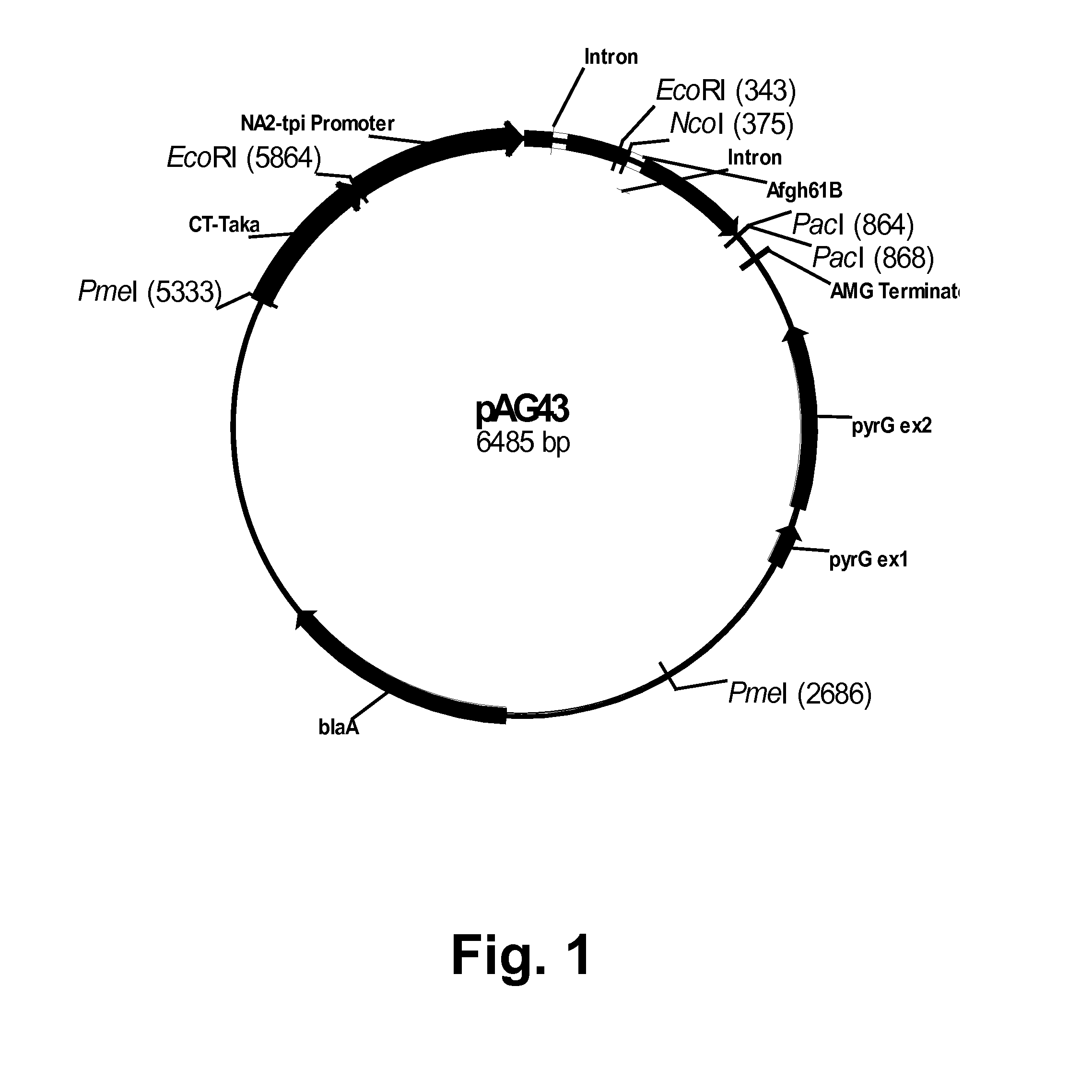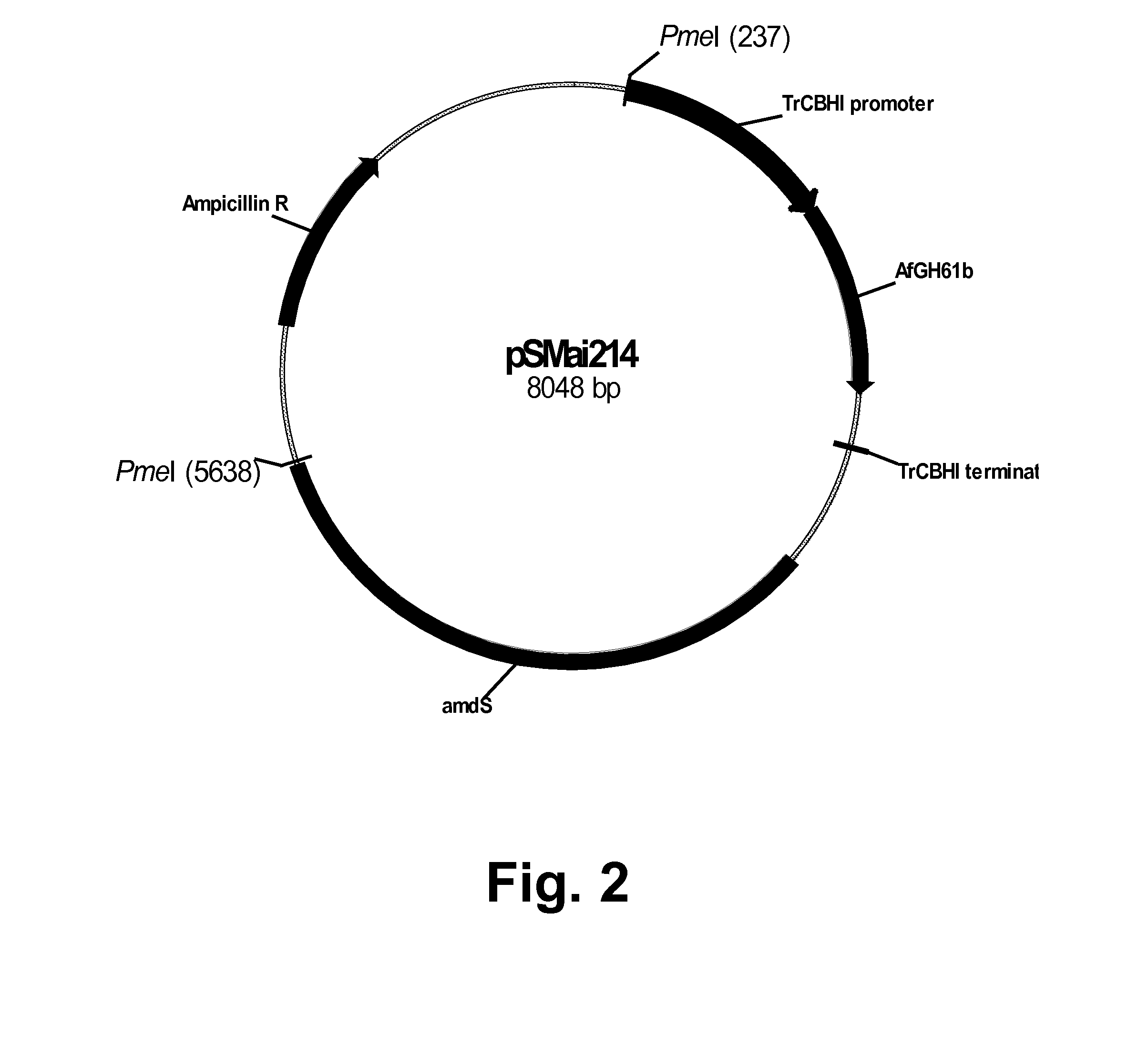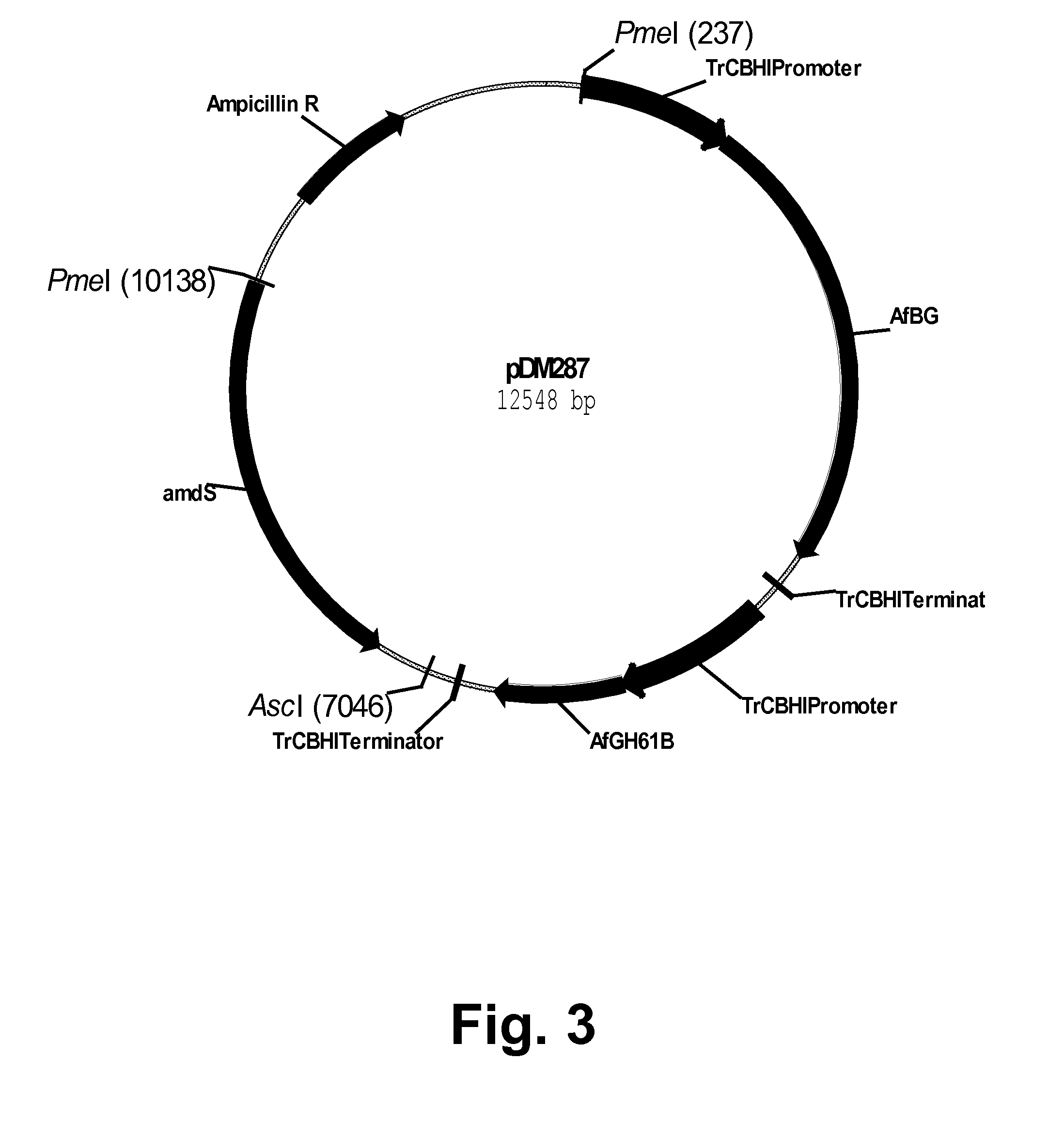Methods For Producing Multiple Recombinant Polypeptides In A Filamentous Fungal Host Cell
a filamentous fungal and host cell technology, applied in the field of multiple recombinant polypeptides in filamentous fungal host cells, can solve the problems of inefficient co-transformation and limited availability of useful selectable markers
- Summary
- Abstract
- Description
- Claims
- Application Information
AI Technical Summary
Benefits of technology
Problems solved by technology
Method used
Image
Examples
example 1
Cloning of an Aspergillus fumigatus GH61B Polypeptide Gene
[0236]A tblastn search (Altschul et al., 1997, Nucleic Acids Res. 25: 3389-3402) of the Aspergillus fumigatus partial genome sequence (The Institute for Genomic Research, Rockville, Md., USA) was performed using as query several known GH61 polypeptides including the Thermoascus aurantiacus GH61A polypeptide (GeneSeqP Accession Number AEC05922). Several genes were identified as putative Family GH61 homologs based upon a high degree of similarity to the query sequences at the amino acid level. One genomic region of approximately 850 bp with greater than 70% sequence identity to the Thermoascus aurantiacus GH61A polypeptide sequence at the amino acid level was chosen for further study.
[0237]A. fumigatus NN051616 was grown and harvested as described in U.S. Pat. No. 7,244,605. Frozen mycelia were ground, by mortar and pestle, to a fine powder and genomic DNA was isolated using a DNEASY® Plant Maxi Kit (QIAGEN Inc., Valencia, Cali...
example 2
Construction of pSMai214 for Expression of the Aspergillus fumigatus GH61B Polypeptide
[0244]The Aspergillus fumigatus GH61B polypeptide coding sequence was amplified from plasmid pAG43 (Example 1) using the gene-specific forward and reverse primers shown below. The region in italics represents vector homology to the site of insertion for an IN-FUSION® reaction.
Forward primer:(SEQ ID NO: 37)5′-GGACTGCGCACCATGACTTTGTCCAAGATCACTTCCA-3′Reverse primer:(SEQ ID NO: 38)5′-GCCACGGAGCTTAATTAATTAAGCGTTGAACAGTGCAG-3′
[0245]Fifty picomoles of each of the primers above were used in a PCR reaction composed of 10 ng of pAG43 DNA, 1×Pfx Amplification Buffer, 1.5 μl of a 10 mM blend of dATP, dTTP, dGTP, and dCTP, 2.5 units of PLATINUM® Pfx DNA Polymerase, and 1 μl of 50 mM MgSO4 in a final volume of 50 μl. The amplification was performed using an EPPENDORF® MASTERCYCLER® 5333 epgradient S programmed for 1 cycle at 98° C. for 3 minutes; and 30 cycles each at 98° C. for 30 seconds, 56° C. for 30 seconds...
example 3
Construction of a Tandem Construct pDM287 for Expression of Both Aspergillus fumigatus CEL3A Beta-Glucosidase and Aspergillus fumigatus GH61B Polypeptide
[0248]An A. fumigatus GH61B polypeptide expression cassette was amplified from plasmid pSMai214 using the gene-specific forward and reverse primers shown below. The region in italics represents vector homology to the site of insertion for an IN-FUSION® reaction.
Forward primer:(SEQ ID NO: 39)5′-CGCGGTAGTGGCGCGGTCGACCGAATGTAGGATTGTT-3′Reverse primer:(SEQ ID NO: 40)5′-TTACCAATTGGCGCGCCACTACCGCGTTCGAGAAGA-3′
[0249]Fifty picomoles of each of the primers above were used in a PCR reaction composed of 25 ng of pSMai214 DNA, 1× PHUSION™ High-Fidelity Hot Start DNA Polymerase Buffer (Finnzymes Oy, Espoo, Finland), 1 μl of a 10 mM blend of dATP, dTTP, dGTP, and dCTP, and 1 unit of PHUSION™ High-Fidelity Hot Start DNA Polymerase (Finnzymes Oy, Espoo, Finland) in a final volume of 50 μl. The amplification was performed using an EPPENDORF® MASTERC...
PUM
| Property | Measurement | Unit |
|---|---|---|
| Fraction | aaaaa | aaaaa |
| Fraction | aaaaa | aaaaa |
| Fraction | aaaaa | aaaaa |
Abstract
Description
Claims
Application Information
 Login to View More
Login to View More - R&D
- Intellectual Property
- Life Sciences
- Materials
- Tech Scout
- Unparalleled Data Quality
- Higher Quality Content
- 60% Fewer Hallucinations
Browse by: Latest US Patents, China's latest patents, Technical Efficacy Thesaurus, Application Domain, Technology Topic, Popular Technical Reports.
© 2025 PatSnap. All rights reserved.Legal|Privacy policy|Modern Slavery Act Transparency Statement|Sitemap|About US| Contact US: help@patsnap.com



